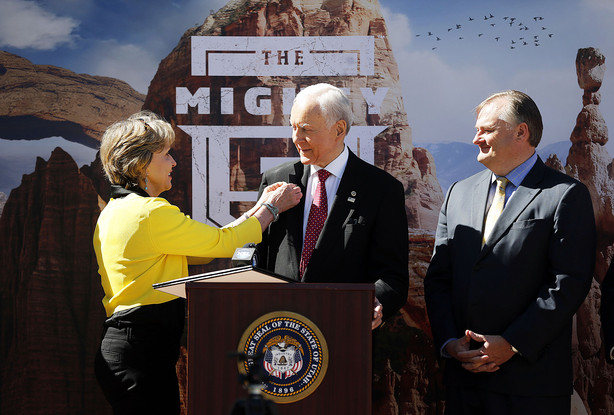
SALT LAKE CITY — With natural wonders, skiing and more, it’s no surprise that the tourism industry is a valuable asset to Utah’s economy.
How valuable is tourism in Utah? According to the Utah Office of Tourism, travelers spent $8.17 billion in 2015 — leading to $1.15 billion in tax revenue for the state, Carter Williams with KSL News reports.
That is, according to the bureau, an equivalent to each household in Utah paying an extra $1,235 in taxes to the state.
Tourism has been a booming industry for Utah over the past decade or so.
“We didn’t really invest into our tourism industry until about 10 years ago and since the state started making a serious investment, it (has) reaped a lot of rewards economically,” said Vicki Varela, managing director for Utah’s Office of Tourism.

Utah brought in $5.7 billion in 2005 and revenue has steadily increased since. With a jump in nearly $2.5 billion over the course of 10 years, Varela said a good reason for that has been because of all that Utah offers outdoors. Utah officials began “Greatest Snow on Earth” and “Mighty 5” campaigns for its slopes and national parks in recent years.
Nearly 8.37 million visited Utah’s national parks and another 4.5 million visited Utah’s slopes in 2015 — each double-digit percentage increases from 2014. It was estimated that more than 10 million came to parks in 2016, based on preliminary National Parks Service reports.
“We’ve worked very hard to help people understand that some of the most spectacular landscapes on the face of the Earth are here in Utah,” Varela said. “We’d like to say Mother Nature played favorites. So we really have become a bucket list for people all over the world for recreation and adventure.”
According to the Kem C. Gardner Policy Institute, about $6.98 billion of the $8.17 billion came from nonresidents spending on various areas such as gasoline, transportation, lodging and dining.

California led all states among nonresident visitors in Utah. Idaho, Nevada and Washington, Colorado and Arizona rounded out the other highest-contributing states.
Tourism is a top 10 industry in Utah and the state’s largest export industry, Varela said. Tourism-generated jobs have jumped from 124,500 in 2006 to 142,500 in 2015.
Other areas of revenue include such tourism events as Outdoor Retailer, a trade show that brought in thousands to showcase the latest and greatest in outdoor gear. However, the organizers of that show announced earlier this month to exclude Utah from future consideration of the show.
The show brought in roughly $45 million for the state.
Read more: Outdoor trade show leaving Utah over public lands stance
Varela said she was sad to see that decision made. However, she was hopeful Utah might be on the radar for other similar trade shows.
“There are many outdoor recreation shows and we’ll continue to seek opportunities to host other shows and to continue to demonstrate all the ways that Utah in so friendly to outdoor recreation,” she said.
So where does that money go?

“State sales tax revenue generated by travelers helps fund a variety of Utah priorities, including education, public safety, health and human services, road construction and maintenance. Tourism significantly bolsters the economy and strengthens our tax base,” said Gov. Gary Herbert in a statement.
The $1.15 billion in taxes funded more than $100 million for Utah’s public schools, according to the Gardner Policy Institute.
Money collected from gas taxes resulted in more than $100 million toward the state’s transportation and infrastructure. Another $200 million from sales taxes went toward essential services, such as health and human services, the justice system, corrections services, public safety and economic development.
Thus making tourism a valuable industry.
Read the full story here: KSL News.
Written by CARTER WILLIAMS, KSL News.com.
Email: [email protected]
Twitter: @STGnews
Copyright 2017 KSL.com
Yeah, but runnin cows in Escalante Grand Staircase NM brings in $2 million in direct wages. If we didn’t have the gol-danged hippies runnin the show we could double that. Californites stay home. We don’t need yer filthy money.
Based on what I’ve read, Utah can stop promoting their national parks, especially Zion. A friend from Cali wants to visit me over Memorial day weekend and go to Zion…I’m dreading it. Love Zion, not the crowds.
Soooooo, does this mean they won’t increase the tax on food?
Of course they will
The hillbilly ignorance “Bender” displays about those gal-darned Cali-hippies is typical. St. George would still have one street, the Blvd. If it weren’t for Californian’s spending their retirement years & savings in this hot, windy, cold, and dirty place!
Utah dont need no turasts. Cows and guns and pocket constitushans only.